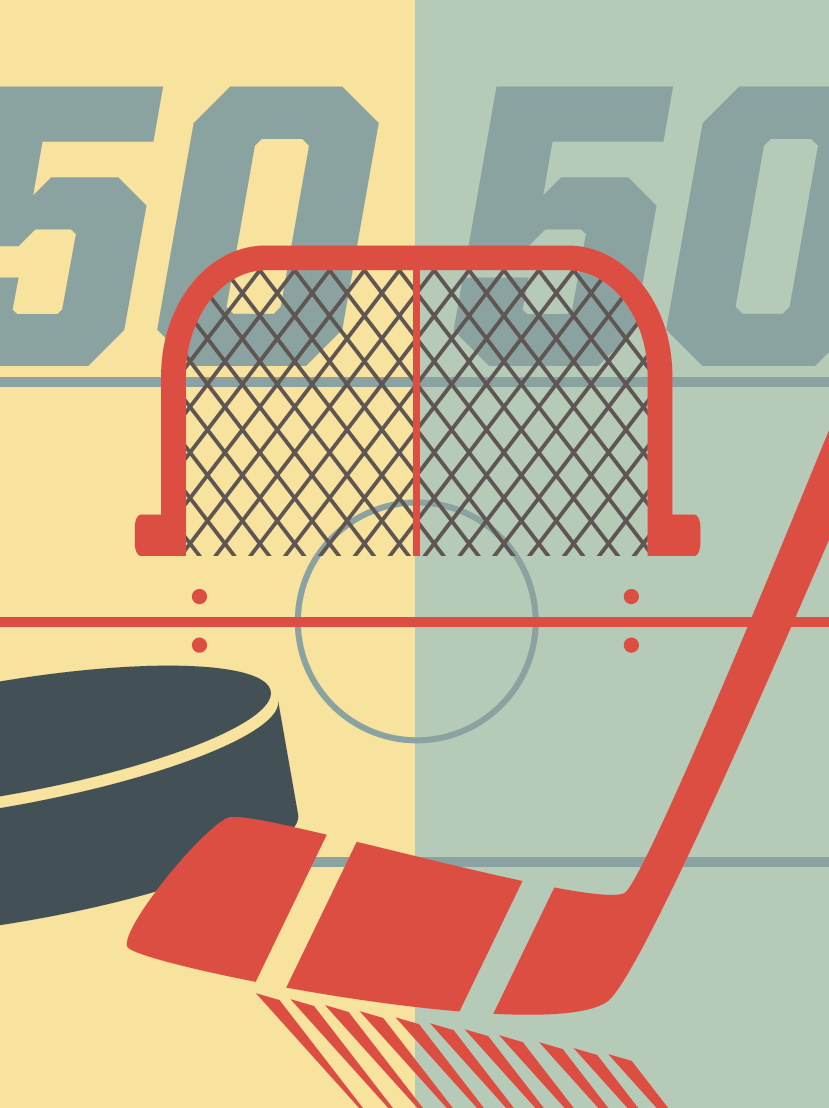
CHEAT SHEET
- The Canadian context. Government regulation of 50/50 raffles has not complicated their implementation in Canada.
- The US experience. Tailgating, an outside-the-stadium activity, keeps fans from entering the stadium early, which limits the number of raffle tickets sold before the game.
- The impetus of technology. Electronic raffling systems are touted as being more efficient, reducing waste, lowering labor costs and promoting participation.
- Considerations for in-house counsel. What are the applicable laws or rules relating to ticket fees, prize limits and other specifics of operating a raffle?
Who wouldn’t like to make a quick buck? Take this scenario: Your favorite charity raises funds, your company benefits from optics and increased revenue, and your customers and supporters get to have some fun and the chance to make a buck, too. That’s the win-win-win logic that many sports teams are using when they host 50/50 raffles at their games. Whether you are in-house counsel for a charity, sports team, Fortune 500 corporation or any type of organization in between, you may be able to take away a thing or two — or 50 — from this game of chance and the experience of professional sports.
What is a 50/50 and how is it used?
Named for how the funds are disbursed, 50/50 raffles are increasingly being used as an easy way for organizations to raise funds for charity at a minimal initial investment and cost. Participants purchase tickets at a low, predetermined amount, like $1 per ticket or five for 10 dollars. The holder of the winning ticket is awarded half of the proceeds from ticket sales (and typically must be present to win). The other half of the pot is awarded to a charitable organization.
Obviously the charity and the winning ticket holder get a great financial benefit from these 50/50 raffles. But while the team or other event host doesn’t take away any of the money from the pot, they do receive some indirect benefits. The raffles are seen as a good way to draw attention to the organization and event where the 50/50 is held; they add to the experience, giving fans or attendees some extra fun in which to participate, and they can encourage publicity and increased attendance rates. They can also lead to increased concession sales due to larger crowds and attendees staying longer at the event to see if they won the raffle. Further, most jurisdictions allow for some form of sponsorship of the raffle, which might mean the raffle has an overall sponsor, or that space on the tickets can be sold for advertising; this not only brings in more revenue, but it can provide an added marketing tool for sponsors who partner to add their names to the initiative. All of these benefits are capped off by the “feel good” aura the participants feel for contributing to a good cause that can directly benefit their community.
The rise of 50/50 raffles in professional sports
Fifty-fifty charity raffles have long been a part of sporting events in Canada, and are now rising in popularity at sporting events in the United States. Up until the past several years, such programs were illegal in many states and frowned upon within the sporting community as gambling. However, cultural and legal shifting in the United States, as well as evolutions in technology – each heralded by entrepreneurial Canadian companies – have lead the powers that be in American professional sports to look to the example of their neighbors to the north.
The Canadian context
Fifty-fifty raffles are squarely entrenched in the sports culture in Canada, and can be found anywhere from the local or amateur level, such as at local curling club tournaments, to professional leagues, like the National Hockey League (NHL). Kevin Lovitt, President of Pointstreak Sports Technologies (“Pointstreak”), the parent company of electronic raffling system Pointstreak 5050, remarks that the 50/50 raffle is such an integral part of the game day experience, that “Fans walk into the building and the first thing they say is ‘Where do I get my 50/50 ticket?’” Lovitt says this results in the pot “growing to a sizeable level well before the start of the game, which in turn increases the excitement and entices more people to participate.”
Not only have Canadian fans come to expect 50/50 raffles as part of their sporting event experience, the Canadian nonprofit community also relies on them. Charitable gambling is a large source of funding for many Canadian organizations. Currently, the greatest number of raffle licenses in Canada is issued to sports groups, followed by social groups, agricultural groups, social action groups and foundations. Of the foundations benefiting from raffles, most are service groups, followed by foundations affiliated with sports teams, and then agricultural organizations.
Further, government regulation of 50/50 raffles has not been an obstacle to their implementation in Canada (like it has been in the United States). Gaming is regulated at the provincial level, and all of Canada’s 10 provinces and three territories allow charitable gambling so long as a recognized charitable organization is the beneficiary. The legal framework for 50/50 raffles in Canada is thus quite favorable. Not only are 50/50s largely allowed to take place at sporting events, they have even been encouraged by governing bodies. Furthermore, unlike in the United States, winners of 50/50 raffles in Canada do not have to pay taxes on their winnings, thus Canadians have even more of an incentive to participate.
Perhaps because 50/50 raffles are so firmly rooted in Canadian sports culture and the legal structure, public opinion of them is largely favorable. Though raffles are considered “gaming” they are not viewed as harmful to society; the majority of the public knows where raffle proceeds go and feel it is to a good cause. Culturally, Canadians have embraced the raffling activity, while Americans have continued – at least until recently – to connect these types of programs to gambling, which has traditionally been considered a bad word by the likes of the National Basketball Association (NBA), National Football League (NFL) and Major League Soccer (MLS).
The US experience
As noted, the United States is beginning to pay attention to its neighbors to the north, and 50/50 charitable raffles have recently begun to gain steam with US sporting events. They have not been as prevalent in the United States as in Canada due to differences in laws, with certain types of raffles prohibited or regulated differently in the different jurisdictions; differences in the cultures, including, for instance, American sports fans’ practice of tailgating; and differences in public perceptions, as the American public historically has not had the favorable view toward gambling that exists in Canada, particularly when associated with sports. Before the United States can dive into the 50/50 pot as Canadians have done, it may need to continue breaking down some of the cultural and legal barriers that have been in place for so long.
One cultural barrier stems from American fans’ passion for tailgating. This “outside the stadium” activity keeps fans from entering the stadium early, which cuts down on the number of raffle tickets sold before the game. If fewer tickets are sold before a game, then the pot is smaller at the start; but as the pot grows, so does the buzz and excitement, and the pot can rapidly multiply as more people want to get their tickets to have a chance to win a large amount. A 50/50 raffle is behind the curve if ticket sales before the game are slow. But as some are realizing, if tickets can be sold in the parking lot to tailgating fans, the large crowds and semi-captive audience can serve as the tipping point for the raffle even prior to the start of the game.
A larger cultural barrier for the United States to hurdle may be the perception of raffles as “gambling.” US-based leagues have fought long and hard to keep “gambling” out of their arenas, even going to the extent of prohibiting any team owners from being associated with any gambling entity. However, the tide is turning, as the public’s perceptions of gambling in general seems to have changed over time, and the leagues are recognizing that the “gambling” involved with 50/50 raffles at games has nothing to do with what’s happening on the field, and everything to do with supporting charitable endeavors in their communities, usually through their own charitable arm.
Even attitudes about gambling on the game itself have shifted, as evidenced by a recent op-ed in the New York Times by NBA Commissioner Adam Silver, in support of legalizing – and regulating – sports betting. See Adam Silver, Legalize Sports Betting, NY Times, Nov. 14, 2014 at A27.
Even aside from the cultural and behavioral roadblocks, US law has not been favorable to raffles in the past. Raffles are included in “gaming,” as defined by the US Internal Revenue Service; and gaming activities are regulated at the state level, thus the applicable rules vary from state to state. Generally, states allow only charities and perhaps a few other types of nonprofits to hold raffles, and most require that the raffle be registered or licensed. Licenses are usually limited to nonprofit organizations with purposes consistent with Section 501(c)(3) or 501(c)(4) of the Internal Revenue Code (though usually without referencing those federal designations). Some jurisdictions impose additional requirements, such as a minimum period of time that the charitable organization must have been in existence, a maximum number of raffles that may be conducted each year, or prize limits. In some states, like Utah and Oklahoma, where “any scheme for the disposal or distribution of property by chance among persons who have paid or promised to pay any valuable consideration for the chance” are banned, 50/50 raffles can operate as long as the price of the raffle ticket is recommended rather than required; operators must also make it possible for those who do not buy a ticket to win. Finally, five states, including California, have explicitly outlawed 50/50 raffles, and in others the law is narrowly written, or not clear as to whether or how a 50/50 charitable raffle may be conducted at a professional sporting event.
Lobbying efforts from the proponents of 50/50 charitable raffles have been instrumental in changing the law to allow for 50/50 charitable raffles at US sporting events. Just who has been lobbying state legislatures for these changes? Teams and stadium owners have banded together for this cause – though teams have sometimes taken a back seat to the stadium owners so the public and league perception is that the team is staying clean of any gaming lobbying efforts. And it may come as no surprise that these entities are getting a great deal of help from the raffle technology companies vying to be the team or venue’s 50/50 outside vendor. Canadian companies like PointStreak are now dipping their toes into the US legislative pool in hopes of expanding their client base.
Those lobbying efforts have gotten results, notably in Pennsylvania (See inset interview with Phil Weinberg, Executive VP and GC at Comcast-Spectacor). The Pennsylvania Local Option Small Games of Chance Act was amended in 2012 to allow for 50/50 drawings at major league sporting events (but conspicuously not including football). It was then amended again in late 2013, and went into effect in early 2014, to specifically allow NFL and minor league teams to conduct 50/50 raffles.
An interview with Executive Vice President and General Counsel Phil Weinberg of Comcast-Spectacor
Comcast Sports Ventures d.b.a. Comcast Spectacor is a Philadelphia-based American sports and entertainment company, which owns the Philadelphia Flyers of the National Hockey League (NHL) and formerly owned the Philadelphia 76ers of the National Basketball Association (NBA). The company owns and manages the Wells Fargo Center, plus several community skating rinks in the Philadelphia region known as Flyers Skate Zone.
HOW WERE THE PHILADELPHIA FLYERS INTRODUCED TO THE CONCEPT OF THE 50/50 RAFFLE?
We were familiar with the concept because it was already in the fabric of hockey in Canada. We saw it as a potential way to generate revenue for our nonprofit and community endeavors, through our related charitable arm (Comcast-Spectacor Charities, which encompasses Flyers Charities). Also, one of our executives had a relationship with Pointstreak, a technology company with software offering an efficient way to run a 50/50 raffle, with real-time updates.
AFTER YOUR INITIAL INTEREST, WHAT WERE THE NEXT STEPS YOU TOOK TOWARDS IMPLEMENTING A 50/50 RAFFLE PROGRAM?
Our first step was to speak to other teams using electronic raffling systems. We then engaged with Pointstreak to discuss possibilities for using their system at Flyers games. We quickly learned that the Pennsylvania laws prohibited operating a 50/50 raffle in the way that would work for us. Pennsylvania law did allow 50/50 raffles, but the way it was written, it would not accommodate raffles on the scale of professional sporting events, and the prize and frequency limitations would not work well for sports.
DID YOU STOP YOUR EFFORTS TO BRING A 50/50 RAFFLE TO FLYERS GAMES AT THAT POINT, OR HOW DID YOU PROCEED?
We actually looked at strategy to change the Pennsylvania law. We reached out to other Pennsylvania teams, to see if they wanted to participate in efforts to change the laws so that their organizations could benefit. We got Pennsylvania-based NBA, MLS, NHL, NASCAR and other minor league teams affiliated with major league teams to join the effort. We specifically looked to Pointstreak to take the lead, as they had experience in maximizing gains, as well as lobbying expertise. They took the lead but would come back to us to make sure their efforts were aligned with our goals. The lobbying paid off, and we are now allowed to conduct charitable raffles, via special Pennsylvania legislation.
WHAT ADVICE WOULD YOU GIVE TO ANOTHER GC SEEKING TO IMPLEMENT THIS TYPE OF PROGRAM?
If a team’s GC is looking at adding this to their fundraising efforts, I suggest they look at their state’s law and what other teams in their area are doing, and if necessary work with other teams to make a collective effort to change state legislation.
DID YOU HAVE ANY CONCERN ABOUT THE GAMBLING SENSITIVITY EMBEDDED IN US SPORTS CULTURE?
We touched base with the leagues all along the way. Every team had its own level of sensitivity to gambling. For us, since the 50/50 charitable raffle was already engrained in Canadian hockey, it was not foreign to us as US hockey owners. This familiarity, our prior ownership of a professional basketball team, and the fact that both teams are tenants of the Wells Fargo Center (which we own), lead to an easier cultural acceptance across the board.
HOW DID YOU ROLL OUT THE PROGRAM FOR FLYERS CHARITIES?
Once things moved on the legal front, we did a full synopsis of the law for the operating folks and had a series of meetings to discuss it. The law was not crystal clear. Questions such as “Where within the building can we sell tickets?” and “What time must the sales be cut off?” were discussed at length. All operational questions were vetted through the legal department so as not to jeopardize this revenue stream for our charitable arm. As a result, a number of issues came up in the first iterations of the PA legislation, and it was then amended, with our input. Today, we have a well-oiled internal protocol – Flyers Charities knows how to run the 50/50 and our legal team monitors any changes in the law.
WHAT KIND OF IMPACT HAS THIS HAD ON YOUR FUNDRAISING?
Our pots are currently averaging just shy of $50,000 per game; so we are bringing in about $25,000 per game for Flyers Charities. In total, we are approaching the million–dollar mark. Today, the 50/50 raffle is a significant part of our game.
Thus, despite some obstacles, 50/50 raffles are quickly growing in popularity in the United States and becoming a part of US sporting events. They are now popular in many big league venues, especially NHL arenas, where jackpots can climb to six figures (likely due to their genesis in Canadian sports, particularly hockey). The 50/50 raffles have also made headway at NBA, MLB and NASCAR events. And, in 2012, the NFL finally permitted clubs to run the raffles in their stadiums when it approved a five-year deal for the Arizona Cardinals. Although the NFL has fewer games per season, and thus fewer opportunities to conduct raffles, the size of crowds at games gives benefiting charities great potential to generate revenue. The NFL has developed certain guidelines on 50/50 raffles, but it is largely up to individual teams to decide whether or not to run them. If a team decides to hold a raffle, the NFL must review it before the raffle can be held. In addition, all 50/50 raffles must benefit a charitable organization and teams cannot keep any of the proceeds. Furthermore, NFL teams, unlike in other leagues, are not allowed to sell sponsorship of raffles. Though the NFL has a strong policy against sports gambling, it has reluctantly allowed charitable 50/50 raffles, subject to the aforementioned rules, because they do not involve wagering that is in any way related to what is happening on the field.
The impetus of technology
The introduction of electronic raffling systems has been instrumental in the take-off of 50/50 raffles at professional sporting events. Electronic raffling systems are touted as being more efficient by reducing waste, lowering labor costs and promoting participation. Electronic raffling systems like those offered by Canadian companies Pointstreak and Bump Worldwide Inc. (bought by and made a division of UK company Sportech PLC in June 2014) (“Bump”) in exchange for a percentage of sales, sell tickets to participants through handheld devices or electronic terminals in the venue, and print the tickets on demand. Thus, no unused, printed tickets are wasted, the number of tickets that can be sold is unlimited, and the speed of sales is much faster than with a manually run raffle. Bump’s President Dan Tanenbaum remarks, “manual raffles traditionally have a slow start because no one knows the pot; but with technology, the patron knows the amount, in real time.” Since the electronic systems tabulate as they go, real-time jackpot totals are available to potential ticket buyers at the point of sale, and can even be displayed on scoreboards or elsewhere around an arena. Further, the amount of time that tickets can be sold is extended, since sales don’t need to end early to allow time to count the money before the drawing. Electronic systems also use a random number generator for ticket numbers, which can be more easily audited and tested for accountability than a hand drawing method.
Professional sports teams that now feature electronic 50/50 raffles at their games include the Calgary Flames, Winnipeg Jets and Vancouver Canucks, as well as the Chicago Blackhawks, Detroit Pistons, Cincinnati Reds, Chicago Cubs, Kansas City Chiefs, Orlando Magic, Atlanta Hawks, Buffalo Bills and many more. Proceeds from the raffles benefit the teams’ related foundations, or other charities working in their local communities. Last year, the Detroit Lions launched their first 50/50 raffle, with proceeds benefiting Henry Ford Health’s Josephine Ford Cancer Institute and Living for the City, a community outreach program. Another team putting raffling systems to work is the Pittsburgh Pirates; their raffle proceeds go to their charity effort, Pirates Charities, which supports organizations like the Miracle League of Southwestern Pennsylvania, which constructs and runs baseball fields for those with special needs.
Considerations for in-house counsel
Whether you work for a sports team, a charity or another type of organization, you can learn something from the examples from the world of sports, and you may just be able to implement your own 50/50 raffle, through or for the benefit of your organization. Here are the top 10 questions to ask yourself and others when considering implementing a 50/50 raffle with your organization:
- Do you have an upcoming event and a cause for which you’d like to raise funds?
- Are charitable raffles legal in the state or province where you intend to hold the event?
- If so, are there any local or municipal laws that also apply to raffles?
- Is the organization that will receive money from the raffle a charity or other nonprofit that is eligible to benefit from a raffle?
- Do you need to obtain a license from a regulating body in order to conduct the raffle?
- How will you issue tickets (e.g., by paper or electronically)?
- How will you account for and safeguard funds?
- What are the applicable laws or rules in your jurisdiction relating to ticket fees or limits, prize limits, ticket disclosure language, restrictions on ticket sellers, and other specifics of operating a raffle with which you must comply?
- Are you subject to any league (i.e., NCAA, NFL, NHL, MLB, MLS) or company-wide guidelines on raffles or fundraising?
- Are you subject to any specific taxes or reporting requirements?
Electronic raffles are not only being used by pro sports teams. Academic institutions are employing them to support athletic programs and raise funds for scholarships. When North Dakota State University’s athletic programs transitioned to Division I in 2004, they needed larger athletic budgets, and specifically more athletic scholarships, in order to compete in the division. Their booster club began running 50/50 raffles, selling paper tickets, with half the raffle pot going to the winner, and the other half to scholarships for all sports. And in 2012, they decided to switch to using an electronic raffle system, to streamline ticket sales, and their profits increased from an average of $21,000 to $28,000 per game. The interest in electronic raffling is not limited to the sports world either. Bump’s Dan Tanenbaum gets calls from people having 500 people for a gala, but he says “for an event that size, paper tickets are better; when there are more than 2,000 people at an event, then software is important.”
Since electronic raffling systems bring efficiency and accountability to the process, while also enabling larger volumes of tickets to be sold, and thus larger pots, they’ve increased not just the buzz around 50/50 raffles but also their feasibility, resulting in their growing presence at major league sporting and other events, not just in Canada but now in the United States and elsewhere as well.
Conclusion
The 50/50 charitable raffle has long been part of the experience at Canadian sporting events. Now, with the help of technology, as well as cultural shifting, and even changes to the law, the 50/50 raffle has made a splash in American pro sports, and has moved even beyond that, to collegiate sports. Where will we see it next — concerts, conventions or online? It may be at your company’s next big event!
Further Reading
Raffles(Charitable Lotteries), Report of the Alberta Gaming and Liquor Commission, July 21, 2001 at 11-11.
Don Muret, Booming Charity Raffles Now Target NFL Clubs, Street & Smith’s Sports Bus. J., Apr. 8, 2013 at 12.
Mark Truesdell, Conducting a Raffle, 57 Ass’n Mgmt. at 21.
Bill Shea, Feeling Lucky, Lions Fans? You Can Buy Raffle Tickets at Games, [29.37] Crain’s Detroit Bus., Sept. 9, 2013 at 1.
Bob Karlovits, 50/50 Raffles Ahead of Game for Pirates Charities, McClatchy –Tribune Bus. News, Oct. 5, 2013 at 1.
Case Study: North Dakota State University, Pointstreak 50/50.
The authors gratefully acknowledge the assistance of University of Chicago Law School student Alexandra Tate and George Washington University Business School student Shira Broms.





